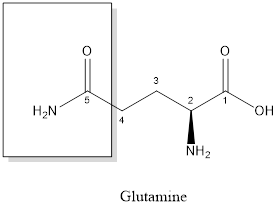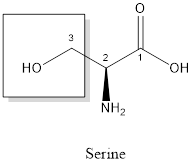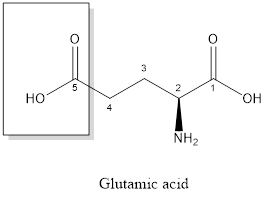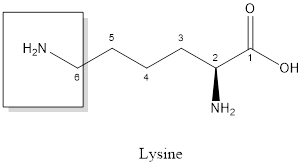
(a)
Interpretation:
The name of the organic
Concept introduction:
Proteins are
They polymerise by peptide linkage to form dipeptide, oligopeptide and polypeptide molecules. Each peptide bond formation is a condensation reaction that occurs with the elimination of water molecule.
Answer to Problem 39A
The name of the organic functional groups present in the side chains of glutamine is amide group.
Explanation of Solution
The given amino acid is glutamine.
The structure of Glutamine is:

In the above structure, the side chain of glutamine consists of a carbon atom which is linked with an oxygen atom by double bond and with nitrogen atom by single bond. This nitrogen atom is further linked with two hydrogen atoms by single bond. Thus, the functional group present in the side chain of glutamine is amide group (-CONH2).
(b)
Interpretation:
The name of the organic functional groups present in the side chain of serine should be determined.
Concept introduction:
Proteins are polymeric biomolecules which are formed by the polymerisation of amino acids. Amino acids are the organic molecules with
They polymerise by peptide linkage to form dipeptide, oligopeptide and polypeptide molecules. Each peptide bond formation is a condensation reaction that occurs with the elimination of water molecule.
Answer to Problem 39A
The name of the organic functional groups present in the side chains of serine is hydroxyl group.
Explanation of Solution
The given amino acid is serine.
The structure of Serine is:

In the above structure, the side chain of serine consists of a carbon atom which is linked with an oxygen atom by single bond. This oxygen atom is further linked with one hydrogen atom by single bond. Thus, the functional group present in the side chain of serine is hydroxyl group (-OH).
(c)
Interpretation:
The name of the organic functional groups present in the side chain of glutamic acid should be determined.
Concept introduction:
Proteins are polymeric biomolecules which are formed by the polymerisation of amino acids. Amino acids are the organic molecules with
They polymerise by peptide linkage to form dipeptide, oligopeptide and polypeptide molecules. Each peptide bond formation is a condensation reaction that occurs with the elimination of water molecule.
Answer to Problem 39A
The name of the organic functional groups present in the side chains of glutamic acid is
Explanation of Solution
The given amino acid is glutamic acid.
The structure of Glutamic acid is:

In the above structure, the side chain of glutamic acid consists of a carbon atom which is linked with an oxygen atom by double bond and another oxygen atom by single bond. This oxygen atom is further linked with one hydrogen atom by single bond. Thus, the functional group present in the side chain of glutamic acid is carboxylic acid group (-COOH).
(d)
Interpretation:
The name of the organic functional groups present in the side chain of lysine should be determined.
Concept introduction:
Proteins are polymeric biomolecules which are formed by the polymerisation of amino acids. Amino acids are the organic molecules with
They polymerise by peptide linkage to form dipeptide, oligopeptide and polypeptide molecules. Each peptide bond formation is a condensation reaction that occurs with the elimination of water molecule.
Answer to Problem 39A
The name of the organic functional groups present in the side chains of lysine is amino group.
Explanation of Solution
The given amino acid is lysine.
The structure of Lysine is:

In the above structure, the side chain of lysine consists of a carbon atom which is linked with a nitrogen atom by single bond. This nitrogen atom is further linked with two hydrogen atoms by single bond. Thus, the functional group present in the side chain of serine is amino group (-NH2).
Chapter 23 Solutions
Chemistry: Matter and Change
Additional Science Textbook Solutions
Biology: Life on Earth (11th Edition)
Physics for Scientists and Engineers: A Strategic Approach, Vol. 1 (Chs 1-21) (4th Edition)
Campbell Biology (11th Edition)
Chemistry: Structure and Properties (2nd Edition)
Campbell Biology in Focus (2nd Edition)
Introductory Chemistry (6th Edition)
- Draw the starting material that would be needed to make this product through an intramolecular Dieckmann reactionarrow_forwardDraw the major product of this reaction. Nitropropane reacts + pent-3-en-2-one reacts with NaOCH2CH3, CH3CHOHarrow_forwardIndicate whether the product formed in the reaction exhibits tautomerism. If so, draw the structure of the tautomers. OC2H5 + CoHs-NH-NH,arrow_forward
- Explain how substitutions at the 5-position of barbituric acid increase the compound's lipophilicity.arrow_forwardExplain how substitutions at the 5-position of phenobarbital increase the compound's lipophilicity.arrow_forwardName an interesting derivative of barbituric acid, describing its structure.arrow_forward
- Briefly describe the synthesis mechanism of barbituric acid from the condensation of urea with a β-diketone.arrow_forwardGiven the hydrazones indicated, draw the structures of the enamines that can be formed. Indicate the most stable enamine (explain). C6H5 C6H5 H C6H5 Harrow_forward4. Propose a Synthesis for the molecule below. You may use any starting materials containing 6 carbons or less (reagents that aren't incorporated into the final molecule such as PhзP do not count towards this total, and the starting material can have whatever non-carbon functional groups you want), and any of the reactions you have learned so far in organic chemistry I, II, and III. Your final answer should show each step separately, with intermediates and conditions clearly drawn.arrow_forward
- Indicate the importance of the indole ring. Find a representative example and list 5 structures.arrow_forwardΌΗ 1) V2 CO 3 or Nalt In منهarrow_forward6. The equilibrium constant for the reaction 2 HBr (g) → H2(g) + Br2(g) Can be expressed by the empirical formula 11790 K In K-6.375 + 0.6415 In(T K-¹) - T Use this formula to determine A,H as a function of temperature. Calculate A,-H at 25 °C and at 100 °C.arrow_forward
 ChemistryChemistryISBN:9781305957404Author:Steven S. Zumdahl, Susan A. Zumdahl, Donald J. DeCostePublisher:Cengage Learning
ChemistryChemistryISBN:9781305957404Author:Steven S. Zumdahl, Susan A. Zumdahl, Donald J. DeCostePublisher:Cengage Learning ChemistryChemistryISBN:9781259911156Author:Raymond Chang Dr., Jason Overby ProfessorPublisher:McGraw-Hill Education
ChemistryChemistryISBN:9781259911156Author:Raymond Chang Dr., Jason Overby ProfessorPublisher:McGraw-Hill Education Principles of Instrumental AnalysisChemistryISBN:9781305577213Author:Douglas A. Skoog, F. James Holler, Stanley R. CrouchPublisher:Cengage Learning
Principles of Instrumental AnalysisChemistryISBN:9781305577213Author:Douglas A. Skoog, F. James Holler, Stanley R. CrouchPublisher:Cengage Learning Organic ChemistryChemistryISBN:9780078021558Author:Janice Gorzynski Smith Dr.Publisher:McGraw-Hill Education
Organic ChemistryChemistryISBN:9780078021558Author:Janice Gorzynski Smith Dr.Publisher:McGraw-Hill Education Chemistry: Principles and ReactionsChemistryISBN:9781305079373Author:William L. Masterton, Cecile N. HurleyPublisher:Cengage Learning
Chemistry: Principles and ReactionsChemistryISBN:9781305079373Author:William L. Masterton, Cecile N. HurleyPublisher:Cengage Learning Elementary Principles of Chemical Processes, Bind...ChemistryISBN:9781118431221Author:Richard M. Felder, Ronald W. Rousseau, Lisa G. BullardPublisher:WILEY
Elementary Principles of Chemical Processes, Bind...ChemistryISBN:9781118431221Author:Richard M. Felder, Ronald W. Rousseau, Lisa G. BullardPublisher:WILEY





